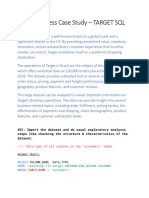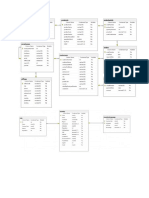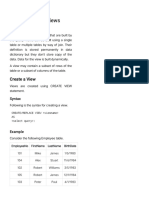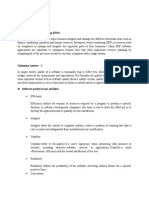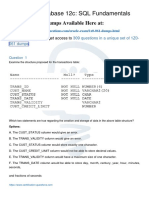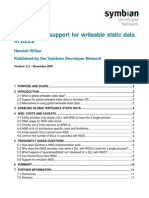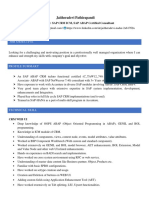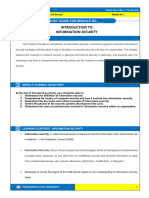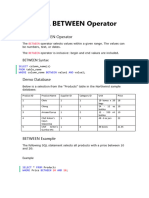Data Visualization Track
Information Technology Institute (ITI)
Smart Village
Analytical SQL Case Study
Submitted by: Hafsa Ahmed Zahran
Submitted to: Eng. Yara Abdallah
2023
1
� Q1: The Query
Step 1:
Exploring the dataset by getting the number of distinct invoices, products, customers, and places
with ex_table (num_total_invoice, num_sold_invoice, num_canceled_invoice ,num_product,
num_customer, num_country)
as(
select
distinct count(invoiceno)as num_total_invoice,
(select distinct count(invoiceno) from Online_Retail where invoiceno not like 'C%') as
num_sold_invoice,
(select distinct count(invoiceno) from Online_Retail where invoiceno like 'C%') as
num_canceled_invoice,
to_char(count(distinct stockcode),'fm999G999G999') as num_product,
to_char(count(distinct customerid),'fm999G999G999') as num_customer,
to_char(count(distinct country),'fm999G999G999') as num_country
from Online_Retail
select
to_char(num_total_invoice ,'fm999G999G999') as num_total_invoice,
to_char(num_sold_invoice,'fm999G999G999') as num_sold_invoice,
round((cast(num_sold_invoice as decimal)/(num_total_invoice))*100, 0) as per_sold_invoice,
to_char(num_canceled_invoice ,'fm999G999G999') as num_canceled_invoice,
round((cast(num_canceled_invoice as decimal)/(num_total_invoice))*100, 0) as per_canceled_invoice,
num_product, num_customer, num_country
from ex_table
2
�Step 2:
To count for each customer the number of invoices they did and order them by the count from the max
to min.
---using with clause & analytical function
with c_table (CustomerID,invoiceno, country,quantity , unitprice,rnk_invoice)
as (
select CustomerID,invoiceno ,country, quantity , unitprice ,
dense_rank () over (partition by CustomerID order by invoiceno) as rnk_invoice
from Online_Retail
select distinct CustomerID,
max(rnk_invoice) over (partition by CustomerID ) as count_invoice
from c_table
order by count_invoice desc
---without analytical function
select CustomerID, count ( distinct InvoiceNo) as num_invoice
from Online_Retail
group by CustomerID
order by num_invoice desc
3
�Step 3:
To rank the country according to number of customers, income they record and the number of invoices
they produce and select the most ordered product and most profitable product.
with c_table (CustomerID,invoiceno, country,quantity , unitprice,description,cnt_invoice,cnt_customer,
fv, pr_country, pr_product)
as (
select CustomerID,invoiceno ,country, quantity , unitprice , description,
dense_rank () over (partition by country order by invoiceno) as cnt_invoice,
dense_rank () over (partition by country order by CustomerID) as cnt_customer,
first_value(description)over (partition by country order by quantity desc) as fv,
sum (quantity * cast (unitprice as decimal)) over (partition by country) as pr_country,
sum (quantity * cast (unitprice as decimal)) over (partition by country, description) as
pr_product
from Online_Retail
select distinct country,
max(cnt_customer) over (partition by country) as count_customer,
max(cnt_invoice) over (partition by country) as count_invoice,
round (pr_country, 2)as Profit ,
fv as most_ordered_product,
first_value(description)over (partition by country order by pr_product desc) as most_profitable_product
from c_table
order by Profit desc
4
�Step 4:
I tried to find out the most profitable month out of the year and its percent rank.
with c_table (year, month , profit ) as
select to_char (TO_TIMESTAMP(invoicedate, 'MM-DD-YYYY HH24:MI:SS'), 'YYYY') as year,
to_char (TO_TIMESTAMP(invoicedate, 'MM-DD-YYYY HH24:MI:SS'), 'Month') as month ,
round (sum (quantity * cast (unitprice as decimal)), 2) as profit
from Online_Retail
group by year, month
select *,
round (cast(percent_rank ()over (partition by year order by profit desc )*100 as decimal) ,2) as
profit_percent_rank
from c_table
order by year, profit desc
5
�Step 5:
To get the top 10 returned product
with t_table (description, quantity,price, loss )
as(
select description , sum(quantity)*-1 as quantity , max(unitprice) as price ,
round(sum (quantity* cast (unitprice as decimal)), 2) as loss
from Online_Retail
where invoiceno like 'C%'
group by description
having sum (quantity) <0
select *
from (
select *, rank () over (order by loss) as rnk
from t_table) t
where rnk <11
6
� Q1: The Story
Our business is an Online retail business which mean that customers have a plethora of options
in searching for, selecting, and purchasing products, information, and services over the
internet.
The business transactions have been recorded over many years and countries, to get an
overview of how the business is going. I thought of analyzing the dataset using SQL.
1. Firstly, I wanted to explore the ongoing business process by answering the following
questions:
- How many invoices did the business did? and how many of them have really
been sold and how many cancelled? and each percentage out of total?
- How many products does the business sell?
- How many customers does the business serve?
- How many counties does the business cover?
to answer these questions, I wrote the query that in step 1, and I found that the
cancelled invoices represent 2% of the total invoices which is a small percentage which
may indicate that our customers are satisfied by the products quality.
2. So, I thought to know the business repeated customers more, so I run the query that is
in step 2, in this query I ordered the customers according to the number of invoices that
they get. When the number of invoices increases this may indicate that this is a frequent
customer who visits our store regularly. I noticed that the customer with the most
number. of invoices doesn't have and id but I decided to keep it in the data
representation to inform the business about this issue.
3. I wrote the query in step 3 cause, I had been inquiring what is the most profitable
country to our business so we can maintain our spread there, and what's the least
profitable countries, in order to give them more attention and try to schedule more
marketing campaigns. I also wanted to see if the most ordered product does mean that
it’s the most profitable product or not.
in some cases, it was the same in other it wasn't, in cases that is not I recommend that
the business try to turn the most profitable product into most ordered too.
4. Later I was wondering if there is a trend in the salles over the last years so run the query
that is in step 4, and I found that the sales may increase in the q2 and q4.
5. Finally, I thought in taking a step forward and try to know the top 10 returned products
so the business may get red off it, and I calculated how much loss they did to the
business by running the query in step 5.
Note: You can navigate by clicking on the step.
7
� Q2: Customer Segmentation
---recency , frequency and monetary
with collection_tabel(customerid, recency,frequency, monetary )
as (
select customerid,
((select max(TO_date(invoicedate,'MM-DD-YYYY' )) from Online_Retail) - max
(TO_date(invoicedate, 'MM-DD-YYYY'))) as recency ,
count(invoiceno) as frequency,
sum(unitprice* quantity) as monetary
from Online_Retail
where customerid != ''
group by customerid
---recency score, frequency and monetary score
calc_rfm (customerid, recency , frequency, monetary,R_S,F_S, M_S ) AS (
select *,
ntile(5) over (order by recency desc) as R_S,
ntile(5) over (order by frequency asc) as F_S,
ntile(5) over (order by monetary asc) as M_S
from collection_tabel
--- joining tables, rounding monetary and frequency and monetary AVG score
t_table(customerid,recency, frequency, monetary , r_score, fm_score) as (
select co.customerid as customerid , co.recency as recency, co.frequency as frequency,
round (cast (co.monetary as decimal ),2) as monetary
8
� ,ca.R_S as r_score , ((ca.F_S+ ca.M_S)/2) as fm_score
from collection_tabel co,calc_rfm ca
where co.customerid= ca.customerid)
---customer segmentation
select * ,
(CASE WHEN r_score in(5,4) AND fm_score in(5,4)
THEN 'Champions'
WHEN (r_score = 5 AND fm_score= 2) or (r_score = 4 AND fm_score= 2) or
(r_score = 3 AND fm_score= 3) or (r_score = 4 AND fm_score= 3)
THEN 'Potential Loyalists'
WHEN (r_score = 5 AND fm_score= 3) or (r_score = 4 AND fm_score= 4) or
(r_score = 3 AND fm_score= 5) or (r_score = 3 AND fm_score= 4)
THEN 'Loyal Customers'
WHEN (r_score = 5 AND fm_score= 1)
THEN 'Recent Customers'
WHEN r_score in(4,3) AND fm_score in(1)
THEN 'Promising'
WHEN r_score in(3,2) AND fm_score in(3,2)
THEN 'Customers Needing Attention'
WHEN (r_score = 2 AND fm_score= 5) or (r_score = 2 AND fm_score= 4) or
(r_score = 1 AND fm_score= 3)
THEN 'At Risk'
9
� WHEN (r_score = 1 AND fm_score= 5) or (r_score = 1 AND fm_score= 4)
THEN 'Cant Lose Them'
WHEN r_score in(1) AND fm_score in(2)
THEN 'Hibernating'
WHEN r_score in(1) AND fm_score in(1)
THEN 'Lost'
END) as cust_segment
from t_table
10































